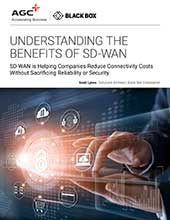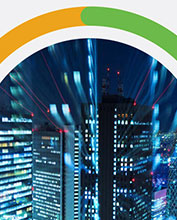Greater Network Efficiency and Business Resiliency
The shift from working in the office to working at home has increased the number of devices, physical sites, and network traffic. IT departments, facing the daunting task of supporting hundreds – even thousands — of remote workers, have prioritized digital transformation projects to meet new demands, including:
- Safeguarding network traffic
- Providing security for every employee, everywhere
- Reimagining safe and secure office spaces
CIOs/CFOs are turning to Black Box to help them define, design, and implement the future of work, including what business resiliency and digital transformation mean for their enterprises — and how to anticipate and capitalize on new market opportunities created by shifts in consumer and employee behavior.
Respond, Retool, and Reimagine
The pandemic accelerated the need for enterprises to modernize technology infrastructure and reimagine business, including accelerating data and digital platforms. Black Box can help enterprises design, deploy, and manage an optimized network for secure work — whether it’s remote, onsite, or hybrid.
![]()
Secure Remote Worker
Give your enterprise secure network access, ensure data privacy, maintain control and enforcement policies, and protect against malware across an exponential growth in endpoints.
![]()
Reimagined Workplace
Create and maintain a post-pandemic workplace that’s safe for boundless collaboration and true resiliency, including working from anywhere on any device with all policies and procedures in tow.
![]()
Transformed Network
Design a resilient network environment and deploy it locally and/or globally, at one site or hundreds with consistent, fast, repeatable outcomes. Back it up with remote IT support, proactive maintenance and expert monitoring.
Edge Networking Transformation
Black Box’s technicians specialize in core capabilities that can help your enterprise securely optimize its network for remote traffic; safeguard corporate assets; and build a phased plan that makes the most effective use of your existing environment and maps out the digital transformation journey.

SD-WAN
Connects enterprise networks — including branches and data centers — over large geographic distances providing centralized visibility, automation, and security.

Wi-Fi 6
Supports a distributed mobile workforce wirelessly indoors and out (in converged management with 5G).

Security
Integrated solutions include advanced security features, embedded automation, and intelligence tools to optimize and secure core and edge networks.

Global Multisite Deployments
Manages installs in a timely, repeatable way across hundreds of sites around the globe.

So Long 9-to-5
Attracting and retaining top talent in the new hybrid work environment.
The COVID-19 pandemic upended the workplace and freed employees to work securely from home. This liberation from the daily grind has resulted in increased productivity, better work/life balance, and savings for employees and corporations. The benefits are so great that major corporations have announced plans to offer the perk of a hybrid work environment — one where employees work in a remote/in-office combination.
Read this guide to find out how your business can retool and reimagine your current legacy system to support an exponential amount of users, devices, and locations.
Customer Success Stories
Black Box works with clients around the globe to address the unique challenges of edge network transformation, including these impressive success stories:

Manufacturer’s Network Optimization Saves $3M
A large food manufacturer turned to Black Box for help optimizing its network, upgrading its unified communications system, and supporting them after installation. The result was enhanced security and efficiency that lead to a projected savings of approximately $3 million.

Airport Foils Ransomware Attack
A large, North American, international airport, decided not to pay on a ransomware attack. Instead, they turned to Black Box. Our experts isolated the “infection,” procured new equipment, rebuilt the network, and reinstalled data from backups. The resulting value totaled over $2 million. Read Full Case Study.

Hospital’s HIPAA Maintained Remotely At $1.2M Value
A Top 5 North American hospital network turned to Black Box to provide employees with secure, HIPAA-compliant remote access via cloud management. Results included potential reallocated hospital space, lower business risk, additional remote work opportunities, and a $1.2 million recognized value for investment in security devices. Read Full Case Study.

Municipality Adds Secure, Remote Access; Gains $1.1M In Productivity
During the lockdown, a Northeast municipality employees couldn’t access files and applications remotely due to the absence of security features. Black Box provided a security platform that protected access to data for all users, devices, and applications. The result was a $1.1 million gain in productivity — plus millions saved by thwarting security breaches and ransomware attacks.

Centralize 300+ Disparate Healthcare Networks
A growing healthcare consortium needed to simplify and consolidate 300+ homegrown field office networks for manageability, agility, and HIPAA compliancy. By leveraging Black Box's expertise and national service teams, they received a centrally managed, integrated SD-WAN network that mitigated risk, met all HIPAA requirements, and guaranteed 99.999% uptime. Read Full Case Study.

Pandemic-Safe NOC for Miami Airport
When the pandemic hit, the Black Box team faced the daunting challenge of how to quickly transition Service-Desk Agents to a remote and socially distanced work environment, yet continue to provide mission-critical network and communications services with no disruption for the Miami International Airport. The team seamlessly cut over to a customized cloud-based solution and realized significant annual cost savings and a major reduction in call waiting and queue times. Read the full case study.
Why Black Box?
For almost 45 years, Black Box has helped clients in all industries and locations around the globe build, secure, manage, reimagine, and transform their networks and IT infrastructure.
Thanks to partnerships with leading manufacturers in digital communication and infrastructure, Black Box can help you shape a consumption model that will revolutionize your work ecosystem — and give your employees the flexibility to collaborate securely and intuitively anywhere, anytime, on any device.
So whether you’re a large healthcare enterprise or retailer, a small manufacturer, or somewhere in between, Black Box’s 2,500 team members have the know-how to help you engineer business continuity and innovation.
Business Resiliency and Digital Transformation
What does the modern workforce look like? Gain new insight and understanding from our Edge Networking experts as they help you make sense of secure hybrid work models, the post-pandemic office environment, and fluid business operation.


The Power of Wi-Fi 6
The Institute of Electrical and Electronic Engineers (IEEE) is the organization responsible for the standards that define modern wireless enterprise networks, for example, WLANs. Industry interests are coordinated through the Wi-Fi Alliance. They select the subset of features that become the minimum set of features for certified hardware, software, and devices. They also control the use of trademarks.
The IEEE uses a unique numbering sequence for every standard. The 802 standard is for networking but is further broken down into 22 subparts. 802.11 is the sub-part for wireless networking. Over the past 20 years, the 802.11 standard has been updated many times beginning with revision 802.11a and continuing through 802.11ax. Some of the updates addressed specific technical shortcomings (for example, QoS) of the original standard, while others substantially changed fundamentals of the wireless protocol (for example, QAM modulation). In retrospect, the fundamental changes were generational changes.
What is Wi-Fi 6?
It is simply the IEEE and Wi-Fi Alliance acknowledging the benefit of explicitly identifying the major generational changes within the 802.11 specification family. See the table below.
| New | Previous |
| Wi-Fi 1 | 802.11a |
| Wi-Fi 2 | 802.11b |
| Wi-Fi 3 | 802.11a, g |
| Wi-Fi 4 | 802.11n |
| Wi-Fi 5 | 802.11ac |
| Wi-Fi 6 | 802.11ax |
What is new in Wi-Fi 6?
The technical changes equip Wi-Fi 6 to handle very high user device density per access point (AP) and the demands of 4K and 8K streaming video or multiuser virtual/augmented reality (VR/AR). There are four significant changes.
The first three changes are only applicable to 802.11ax APs communicating with 802.11ax user devices. The first change is an increase from 4 x 4 MIMO to 8 x 8 MIMO that can direct the eight data streams to a single user (achieving higher peak speed) or simultaneously assign one data stream to each of eight users, for example, multi-user MIMO (achieving lower average latency). The second is an increase in the RF signal modulation from 256 quadrature amplitude modulation (QAM) to 1024 QAM for 25 percent higher peak speeds for users in close proximity to the AP. The third change adds scheduling to the OFDM (becoming OFDMA) to provide deterministic use of the time-frequency resources when all devices are participating in MU-MIMO. The fourth change uses the increased number of antennas required to support 8 x 8 MIMO to provide more directional beamforming and allows more effective noise suppression (maximum ratio combining [MRC]), providing benefit to all users, including legacy users.
802.11ax still uses the original Carrier Sense Multiple Access (CSMA) technique using Clear Channel Assessment (CCA). CCA/CSMA is contention based, not deterministic, and is the root cause of most Wi-Fi latency and jitter issues. When all devices are 802.11ax, the CCA thresholds can be adjusted for higher average AP capacity – with the trade-off of potentially lower peak speeds.
When should you upgrade to Wi-Fi 6?
Enterprise WLANs should be upgraded on a six- or seven-year cycle to avoid network equipment end of life (EOL) or end of support (EOS). If you have a validated use case involving high user density and streaming video, then Wi-Fi 6 is the obvious choice.
If your usage scenarios are more typical enterprise applications, then upgrade with current mainstream equipment – Wi-Fi 5 or Wi-Fi 6.
If you would like to receive our quarterly newsletter, View from the Edge, you can sign up here.
Where Do We Start?
Work quickly to identify needs and outline a plan of action. Contact a Black Box expert today.
Black Box Industries
Additional Resources
-
Black Box Managed Services in Partnership with Cisco
-
Wireless Connectivity for Retail with Black Box Powered by Juniper Networks
-
Networking Solutions for Higher Education IT Needs
-
Black Box Juniper Solutions in Healthcare Industry
-
A Modern Wireless Platform
-
All Clouds are Not Created Equal
-
Deep Dive
-
AV Solutions for Hospitality
-
Top Considerations for Business Continuity
-
Environmental Monitoring Solution
-
BDS-8 Temperature Screening Kiosk
-
AlertWerks Wired Solution for Data Centers
-
iCompel Digital Signage Solutions
-
KVM Extenders and Switches
-
MCX AV-over-IP Solutions
-
What is CBRS?
-
The Future of 5G in Healthcare
-
What's Driving Trends in UCaaS
-
State of Hybrid Work Report
-
Migrating to Avaya Cloud Office Fact Sheet
- 1 (current)
- 2
- 3
- 4
- 5







